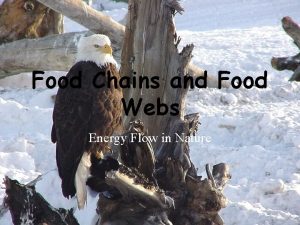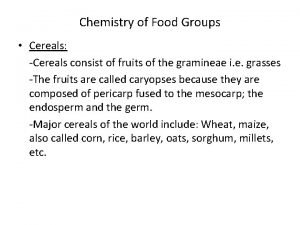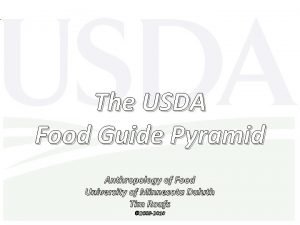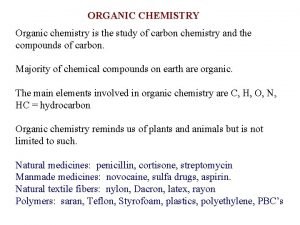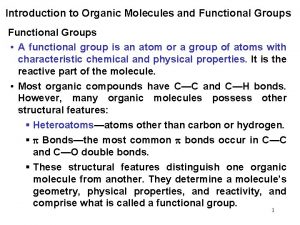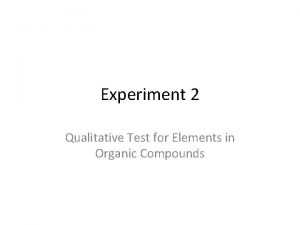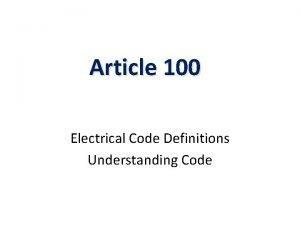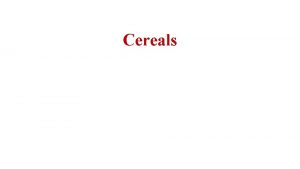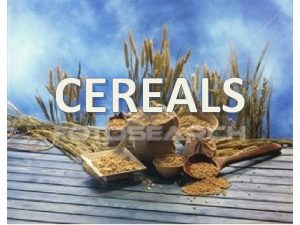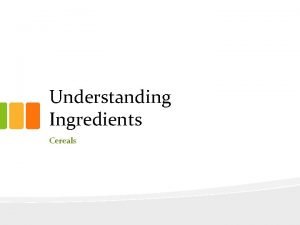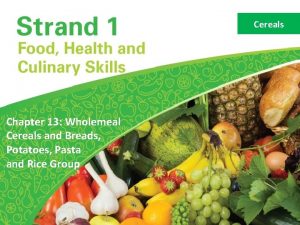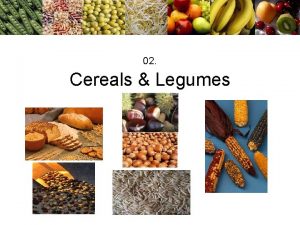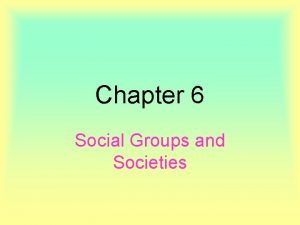Chemistry of Food Groups Cereals Cereals consist of

























- Slides: 25

Chemistry of Food Groups • Cereals: -Cereals consist of fruits of the gramineae i. e. grasses -The fruits are called caryopses because they are composed of pericarp fused to the mesocarp; the endosperm and the germ. -Major cereals of the world include: Wheat, maize, also called corn, rice, barley, oats, sorghum, millets, etc.

-They are generally called grains, because they are generally used in the dry form; however, they may be regarded as vegetable when used in the fresh wet form e. g. corn on the cob -They are eaten boiled e. g. rice; flaked e. g. corn flake; puffed e. g. popped corn; as gruel e. g. ogi, kunu; as gels e. g. eko jije i. e. stiff form of eko or agidi; and are used for making bread and pastries; brewed into alcoholic drinks e. g. beer; starch; corn oil [by-product of wet milling] etc.


Anatomically the cereal is composed of a pericarp and mesocarp which are fused together. Under the pericarp is the aleurone layer, followed by the endosperm, which is divided into the corneous and the floury endosperm; the endosperm produces the flour The embryo is called germ. It consists of the plumule which grows into the plant and the radicule, which forms the root. Separating the embryo from the endosperm is the scutellum

Composition: Cereals are regarded as starchy foods as they consist of generally between 70 and 80% starch. -There are wide variations in the properties of the starch granules which characterize each cereal and distinguishes cereals from tubers and legumes. Differences in the starch properties also mainly determines the property of the foods made from cereals and the grains e. g. rice. Apart from starch there is also protein (10 -12%), ash (ca 0. 2%), fat (2 -4%), fibre (2 -10%) and vitamins.





Starch: Cereal starch is mainly composed of amylose (2325%) and amylopectin (75 -78%). There are variations to these figures e. g. waxy maize or sorghum has approx. 0% amylose, while high amylose maize has up to 56% amylose. Amylose content determine the texture of starchy foods e. g. rice. Sugars also are found in cereals; about 2%.

Conversion of grain to alcohol (beer). Practically any grain can be used. However barley has been used because it was available and the system has been adapted for barley malt. Process: Malting Grinding mashing Fermenting Sterilizing holding Beer

Protein: -Cereal proteins are generally deficient in lysine. Some in addition are deficient in tryptophan, which makes the consumption of cereal only diets nutritionally deficient. However, what amino acids the cereals lack are in abundance in legumes. Therefore a diet of cereal supplemented with legumes is usually adequate. -Gluten is a protein that is usually linked with wheat flour. However, apart from wheat, rye and to a limited extent, sorghum, may possess gluten. The gluten of corn wet milling process is

not gluten, but a trade term used for extracted protein. Gluten (wheat) consists of 85% protein, 8. 3% lipid, 6% starch and 0. 7% ash. Basically it consists of two fractions, gliadin and glutenin Quality of wheat and the use to which it is applied depend not totally on the gluten content, but on gluten type. Also on starch property. Strong gluten –elastic but fairly tough (hard wheat) for bread making. Weak gluten –very sticky, not very elastic (soft wheat) for cakes, biscuits etc.

Bread baking: Ingredients: wheat flour, water, salt, yeast -required ingredients (others shortening, milk etc). Flour -consists mainly of gluten and starch granules Gluten forms an elastic dough; traps gas and forms a rigid structure on heating Starch –Some (v. little) is broken down by the amylases (α and β amylases) to form sugar (substrate for yeast fermentation); the rest absorbs water and gelatinizes to form a rigid structure during baking.

Leavening agents: Yeast (Saccharomyces cervisiae): Ferments sugar to produce alcohol and CO 2. The CO 2 is captured in the cells developed by the gluten, giving bread its spongy texture. Water also expands (steam) to aerate the dough during baking. Salt (Na. Cl): Serves as yeast food, toughens gluten Ingredients that improve batter elasticity are: 1. Gluten

1. Proteins of milk and egg (particularly egg white) 2. Fats and sugar (tenderizers) decrease elasticity Bread preparation: 1. Dough formation (mixing flour and ingredients) 2. Proofing 3. Degassing 4. Fermentation 5. Baking 6. Cooling

Baking (reactions) –(Potter) 1. Evolution and expansion of gases 2. Coagulation of gluten and gelatinization of starch 3. Partial dehydration from evaporation of water 4. Development of flavours 5. Colour changes due to Maillard browning reactions 6. Crust formation due to surface dahydration 7. Crust browning due to Maillard browning reactions and caramelization of sugars.

Legumes are the seeds of the Leguminoseae plants. These are plants that have root nodules to fix N 2. They comprise of pulses and oilseeds. Pulses are legume seeds that have low oil contents (1 -2%) e. g. bean (black eyed pea), Faba bean, field pea etc. Oilseeds have high oil contents e. g. soybean (> 20% oil), groundnuts etc. Legume seeds are noted for their high protein contents (20 -40%) on dry weight basis.



Legume seeds that are low in fat usually have high carbohydrate content up to 65% for bean i. e. cowpea. The CHO in cowpea is mainly starch (ca 27%). Other carbohydrate components include the sugars raffinose, stacchyose and vabascose, which are not utilizable by man, but which are fermented in the lower intestine by microorganisms into flatulent gases.

Legume proteins are complementary to cereals protein complementing them with the limiting amino acids lysine, tryptophan and threonine. Legume proteins are deficient in methionine, which is not deficient in cereals. Therefore legume proteins and cereal proteins complement one another. Legumes have higher protein content than cereals and therefore are used to supplement cereal proteins

Fish and Meat Fish and meats are generally composed of muscles, fats, bones, vitamins and minerals. Chemical composition of Meat The major component of meat is water. Consists of about 60%. Minerals constitute about 4% Proteins 20% Fats (lipids) 15% Carbohydrate 1%

Approximate chemical composition of an animal like a pig Substance Percentage Inorganic Water 60 Minerals 4 Organic Proteins 20 Fats (lipids) 15 Carbohydrates 1

• Meat is muscle that has undergone a process of conversion after the death of the animal. • Process of conversion:
 Consist of your most important targeted or segmented groups
Consist of your most important targeted or segmented groups Food web bearded dragon food chain
Food web bearded dragon food chain Food web with at least 10 organisms
Food web with at least 10 organisms Grains and cereals food group
Grains and cereals food group Food pyrmid
Food pyrmid How are ethnic groups and religious groups related
How are ethnic groups and religious groups related Unit 2 food food food
Unit 2 food food food Food chain sequence
Food chain sequence Hcl symmetry elements
Hcl symmetry elements Nfo2 molecule
Nfo2 molecule Ib chemistry functional groups
Ib chemistry functional groups Functional groups organic chemistry table
Functional groups organic chemistry table Functional group
Functional group Ag schnelltest beilstein
Ag schnelltest beilstein Is britain and uk same?
Is britain and uk same? Great britain consist of
Great britain consist of What consists of the uk
What consists of the uk Safety net drop tests must consist of a
Safety net drop tests must consist of a English method emulsion
English method emulsion Composition of blood
Composition of blood Overcurrent devices do not have to be readily accessible if
Overcurrent devices do not have to be readily accessible if What does britain consist of
What does britain consist of Linkers
Linkers Servletcontext and servletconfig
Servletcontext and servletconfig Interactivity chart problem solving
Interactivity chart problem solving Chorionic villus
Chorionic villus


